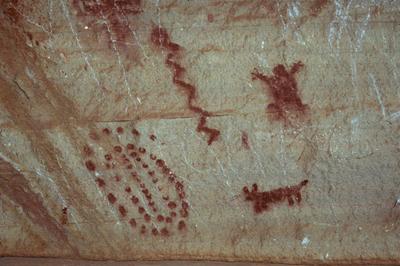Friday, July 01, 2005
A Journey Through Time: Human Habitation of the Canyon
Last in a series on the age, formation and geology of the Grand Canyon.
Young earth creationists, such as John Turney, whose commentary in the Cincinnati Enquirer inspired me to revisit the Grand Canyon in these posts have to contend with another little problem when they maintain that the canyon was formed less than 10,000 years ago.
Paleo hunters followed game into the Southwest at least 11,000 years ago.
Although they left little evidence of their passing, the Blackwater Draw archeological site in New Mexico has produced abundant evidence of Clovis, Portales, and Desert Archaic cultures that show occupation of the site stretching back at least 13,000 years.
Hunters from the Desert Archaic culture left evidence of their passing tucked into rock crevices in the Grand Canyon's redwall -- animal figures shaped from willow twigs -- that have been found to be 4,000 years old by radiocarbon dating.
Radiocarbon (Carbon-14) is created in the earth's atmosphere when nitrogen-14 is bombarded by neutrons created by cosmic radiation. This process is continuous. The carbon-14 mixes with ordinary carbon and diffuses rapidly in the atmosphere. Living organisms take in carbon-14. When they die, they stop taking it in. As the unstable carbon-14 atoms decay, the amount found in the sample decreases. Measurement of the remaining amount of carbon-14 allows us to date the sample
Because carbon-14 has a half-life of 5,730 years, it can't be used to date objects more than 50,000 years old. After that time, not enough carbon-14 is left to give an accurate date. Likewise, the atmospheric testing of atomic weapons means that radiocarbon dating of samples formed after 1945 is not possible. In order to insure that production of carbon-14 in the atmosphere has been constant over time, samples taken from tree rings and wooden beams from Egyptian tombs, among other objects, whose dates we know independently have been tested to insure accuracy.
After leaving Hermit Creek, our group spent two days exploring Monument Creek. On our way out of the inner canyon we followed the Tonto Trail east along the plateau triangulating our position as we went using the Tower of Set, the Isis Temple, and Cheops Pyramid on the north rim for sightings. Even skeptics such as Red State Rabble are moved by the awesome beauty of the canyon. We understand why the canyon's temples got their names -- it's just that our sense of awe drives us to learn more about the natural processes that created these wonders, rather than simply writing them off as having been created by some unknown and unknowable creator.
On our final night in the canyon, we camped at Indian Gardens after cooking dinner and watching the sunset on Plateau Point -- this much to the distress of a young German couple who appeared to be waiting until everyone left in order to make love.
Climbing the Bright Angel Trail to the South Rim we passed the pictographs at the top of this post. After six days of backpacking in temperatures above 100 degrees it was a mere 70 up on the rim and RSR started shivering uncontrollably. A steak dinner at the lodge solved that problem.
Part 1: Journey Through Time
Part 2: Dynamic Forces
Part 3: Rock of Ages








